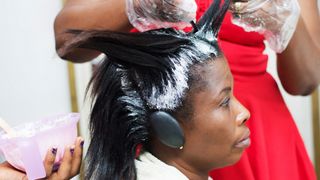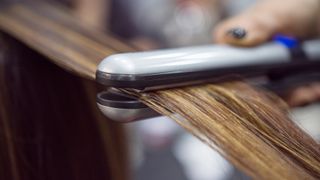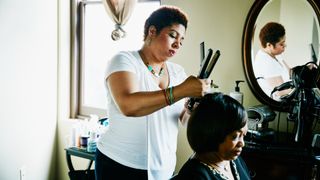
Some hair-straightening and smoothing products contain formaldehyde, but many include other potentially harmful chemicals that have yet to be banned, experts say.
(Image credit: Vystekimages via Getty Images)
Later this month, the U.S. Food and Drug Administration (FDA) is expected to ban the use of formaldehyde in hair-straightening and hair-smoothing products in response to mounting concerns about the ingredient’s harmful health effects. The same ban would also bar chemicals known to release formaldehyde upon being heated.
Formaldehyde — also called formalin or methylene glycol, in its liquid forms — is a known human carcinogen tied to various cancers, such as leukemia and nasopharyngeal cancers, which affect the upper part of the throat. It’s thought to be cancer-causing when inhaled in large amounts or for prolonged periods. Formaldehyde has also been linked to breathing problems, including the onset and exacerbation of asthma in children and adults. In people who regularly work with formaldehyde, the chemical is thought to potentially increase the risk of fertility issues and miscarriage.
Formaldehyde has already been banned as an active ingredient in hair-straightening products in other regions, such as Brazil, Canada and the European Union. However, it is still widely used in these types of hair products in the U.S. Currently, more than 150 hair-straightening products on the market contain formaldehyde, according to the New York State Department of Health. These products are more frequently used by Black people than people of other races.
The expected FDA ban on formaldehyde is “absolutely critical” to protect Americans, Sarah Evans, an assistant professor of environmental medicine and public health at the Icahn School of Medicine at Mount Sinai in New York, told Live Science in an email.
However, truly making such hair products safe for consumers and salon workers will take a lot more work than a policy change regarding a single chemical, Evans and other experts told Live Science.
Related: Chemical found in 1,000 processed foods may harm the immune system
The formaldehyde ban
The new FDA ban would apply to hair-straightening and -smoothing products, which temporarily straighten hair. Those products aren’t to be confused with hair relaxers, which are creamy chemicals used to permanently straighten hair, Jasmine McDonald, an assistant professor of epidemiology at Columbia University, told Live Science. Hair relaxers typically do not contain formaldehyde, she noted.
Get the world’s most fascinating discoveries delivered straight to your inbox.
During straightening and smoothing treatments, the hair is heated and molded into shape. At that time, any formaldehyde in the products is released into the air as a gas. This puts both customers and salon workers at risk of short-term symptoms — like skin irritation, coughing, wheezing and burning sensations in the eyes — as well as long-term risks.
The FDA advises consumers to check product labels for formaldehyde, formalin and methylene glycol and to ask their salon if a product contains formaldehyde-related ingredients. However, “in most cases, you won’t find formaldehyde listed on the product label because it’s produced when other ingredients are heated during the straightening process,” Evans said.
“Even products that claim to be formaldehyde-free have been found to release formaldehyde, making it impossible for consumers to choose safer products,” she said.
Chemicals in hair products that release formaldehyde when heated include timonacic acid, dimethoxymethane, or decamethyl-cyclopentasiloxane. Such substances may be covered under the new ban as “formaldehyde-releasing chemicals.”

Hair-straightening products containing formaldehyde release the chemical as a gas when heated. (Image credit: jopstock via Getty Images)
Other concerning ingredients
Formaldehyde is not the only potentially harmful chemical in hair-straightening products. For example, glyoxylic acid — marketed as a safer alternative to formaldehyde — has been tied to kidney injuries in anecdotal reports and, more recently, in a woman’s case of repeated kidney damage.
Some experts have suggested glyoxylic acid should also be banned from hair care, based on emerging evidence that it can absorb through the skin and damage the kidneys. Glyoxylic acid is also thought to potentially release formaldehyde when heated, although a different break-down product of the chemical has been tied to the kidney issues.
Chemicals added to hair products may already be on the market for other purposes. Glyoxylic acid, for instance, is used to make flavorings, perfumes and pharmaceuticals.
“In general, because of the way laws are set up in the U.S., companies don’t have to test all the chemicals they’re using in their products for safety or efficacy before they use them in their product if they’ve already been on the market,” Tracey Woodruff, director of the Program on Reproductive Health and the Environment at the University of California, San Francisco, told Live Science.
“So there can be chemicals in there that we don’t actually have sufficient health information to evaluate [in particular contexts], and then people are putting them again on their head,” she said.
Hair relaxers, which don’t typically contain formaldehyde, have nonetheless been tied to some types of cancer, such as uterine cancer and ovarian cancer, McDonald said. Some studies show these products can contain heavy metals, as well as phthalates and parabens, which evidence suggests may disrupt people’s hormones.
Related: What makes hair curly?

Research suggests that Black women are much more likely to use hair-straightening products than non-Black women, due to racialized beauty norms. (Image credit: Thomas Barwick via Getty Images)
What the ban could achieve, for now
The new ban on formaldehyde would help make hair-straightening and -smoothing products safer and, especially, make a difference to salon workers who are constantly exposed to the chemical, McDonald said. It may even set a precedent for eliminating other concerning chemicals in other products, such as those used in relaxers and in perms, which texturize straight hair, she said.
However, for people who have used these products since childhood, a new ban would not reverse the long-term health impacts.
“I study environmental exposures during critical periods of life,” McDonald said. “Some of these habits are started quite young, like pre-puberty, and that impacts your lifelong risk of different chronic conditions.”
Beauty norms that differ between people of different races have cemented the consistent, long-term use of these products in certain communities, despite their potentially harmful effects. Especially among women of color, McDonald said, there’s a pressure to conform to “Eurocentric” views that straight, long, smooth hair is beautiful. People with textured hair — namely, Black people — are known to face discrimination in school and the workplace because of it, prompting various states to pass laws against hair discrimination. A similar federal law was introduced but never passed.
These discriminative beauty norms have resulted in an “overburden of exposure” to certain products, McDonald said. For instance, a 2023 study by McDonald and colleagues of nearly 300 women and femme-identifying individuals in New York found that Black people were twice as likely to have ever used chemical straighteners than non-Black people.
“So the fact of the matter is that it’s great to do more [to make these products safe], but we also need to recognize that it’s not enough,” McDonald said.
In the meantime, there are some steps people can take to make informed choices about these products. Woodruff recommended looking them up on the Environmental Working Group’s (EWG) “Skin Deep” database, which describes ingredients in more than 100,000 personal care products. EWG is a non-profit advocacy organization focused on environmental and public health issues.
McDonald also encouraged people to use apps that let you scan product barcodes to see what chemicals are in them and whether they are safe, as well as ask your hairdresser which products they’re planning to use, she said.
Ultimately, though, “what we’re talking about with the formaldehyde ban is a system-level change — a policy change,” McDonald said.
“Because honestly, the individual should not have to know that formaldehyde is a carcinogen,” she said. “It should just be an automatic safe choice.”
This article is for informational purposes only and is not meant to offer medical advice.
Ever wonder why some people build muscle more easily than others or why freckles come out in the sun? Send us your questions about how the human body works to [email protected] with the subject line “Health Desk Q,” and you may see your question answered on the website!
Emily is a health news writer based in London, United Kingdom. She holds a bachelor’s degree in biology from Durham University and a master’s degree in clinical and therapeutic neuroscience from Oxford University. She has worked in science communication, medical writing and as a local news reporter while undertaking journalism training. In 2018, she was named one of MHP Communications’ 30 journalists to watch under 30. ([email protected])
>>> Read full article>>>
Copyright for syndicated content belongs to the linked Source : Live Science – https://www.livescience.com/health/toxic-formaldehyde-in-hair-straightening-products-to-be-banned-but-experts-say-its-not-enough































